Brain Mapping Foundation (BMF) and Society for Brain Mapping and Therapeutics (SBMT) Present the 2014 Prestigious Pioneer in Healthcare Policy Award to Prime Minister of Australia Tony Abbott, the US Congressman Chaka Fattah and shed light on the importance of working as a consortium
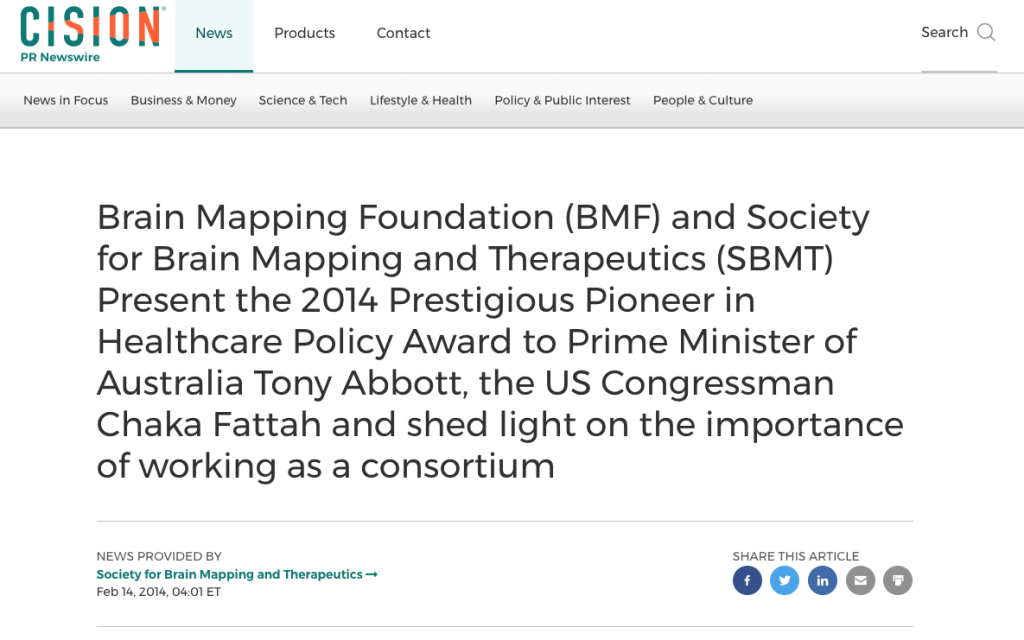
BEVERLEY HILLS, Calif., Feb. 14, 2014 /PRNewswire-USNewswire/ — Today, the Brain Mapping Foundation and the Society for Brain Mapping & Therapeutics announced the 2014 recipients of the prestigious Pioneer in Medicine Award, as well as their annual awards to recognize those who have made notable contributions to brain research in various ways, including the Healthcare Policy Award, Beacon of Courage and Dedication Award, and the Humanitarian Award. The Society will honor each recipient at the Brain Mapping Foundation’s Gala on March 17, 2014 at the Four Seasons Hotel in Sydney as part of their 11th Annual World Congress in Australia. Each year, SBMT and the Brain Mapping Foundation recognize individuals who have made a profound impact on our understanding of brain function and related diseases. Nominations are made by members of the society and decisions are made by the awards committee. The Pioneer in Healthcare Policy Award is presented to lawmakers who have demonstrated visionary policies laws that have contributed to the advancement of science, technology, education, and medicine. The past recipients of this prestigious award include California Governor Arnold Schwarzenegger (2008), U.S. Senator Ted Kennedy, U.S. Speaker of the House Nancy Pelosi (2009), U.S. Senator Harry Reid (2010), U.S. Congresswoman Gabrielle Giffords (2011), Canadian Parliament Member Kirsty Duncan (2012), U.S. Congressman Jim Moran (2013), Congresswoman Cathy McMorris Rodgers (2013), and Congressman Earl Blumenauer (2013). This year, Prime Minister of Australia Tony Abbott and the US Congressman Chaka Fattah are the recipients of this prestigious award. Prime Minister Abbott is recognized for his visionary support of brain research through his $200M dementia initiative in Australia. Congressman Fattah is honored due to his impressive track record in promoting neuroscience legislation through the US Congress including his significant role in President Obama’s BRAIN initiative. “These remarkable lawmakers now have joined the impressive list of past recipients of this prestigious award for their remarkable contribution to the field through supporting groundbreaking initiatives.” Dr. Babak Kateb, Founding Chairman of the Board of SBMT and President of Brain Mapping Foundation, and Director of National Center for Nano-Bio-Electronics, Editor of the Textbook of Nanoneuroscience and Nanoneurosurgery, Research Scientist, Department of Neurosurgery, Cedars-Sinai Medical Center, CA, USA. The Pioneer in Medicine Award will be presented to Dr. Kuldip Sidhu for his landmark contributions to stem cell research, including spearheading the building of a unique global consortium for study of the patient-derived stem cells known as induced pluripotent stem cells (iPSC). He co-authored the findings with 2012 Nobel Prize winner Dr. Shinya Yamanaka. “This is also the recognition of an important area of research that is destined to bring a paradigm change in human medicine” said Prof Sidhu. “The awards committee has been impressed with pioneering work of Professor Sidhu. His ground breaking consortium approach is a great example of how Brain Mapping Foundation would like to plan and execute its global alliance for NanoBioElectronic.” said Dr. Shouleh Nikzad, newly elected President of SBMT (2014-2015) and member of the board of Brain Mapping Foundation, Co-chair of the Award Committee, and Senior Research Scientist and Lead of the Advanced UV/Vis/NIR Detector Arrays, Imaging Systems, and Nanoscience Group, at NASA’s Jet Propulsion Laboratory, California Institute of Technology, CA, USA. The Society annually recognizes the remarkable humanitarian work done by one of its members. This year, Professor Charlie Teo will receive the Humanitarian Award for his humanitarian work across the globe including establishing and funding a hospital in India and operating on patients who lack the financial means to get such care across the developing world. “I think you will never go wrong with the philosophy; it is better to give than to receive” stated by Dr. Charlie Teo. “One of the most important goals of the SBMT is to get the best that medicine has to offer to those in dire need who cannot otherwise afford such therapies. Charlie is a clear example of how SBMT and its members bring the cutting edge science and medicine to the impoverished of the world”, Said Ret. U.S. Army Colonel Michael Roy, Professor of Internal Medicine at USUHS and the past President of SBMT (2012-13). Brain Mapping Foundation and Society for Brain Mapping and Therapeutics annually recognize the public awareness efforts of individuals outside of the medical profession. Past recipients of this coveted award include two-time Oscar winner Dustin Hoffman for his role in the movie Rain Man, as well as other efforts of his to raise public awareness of Autism. This year, BMF and SBMT award a remarkable nurse from Sydney Australia, Sharn McNeill, who has been diagnosed by Lou Gehrig Disease (also known as Amyotrophic Lateral Sclerosis or ALS). Sharn ,who is also a nurse and triathlete, has raised awareness about this devastating neurological disorder in Australia and enabled the Brain Mapping Foundation to shed light on the importance of funding to treat neurological disorders in Australia. “I am both deeply touched and very honored to receive this award. My illness has given me a platform to help raise awareness about neurological disorders and the amazing work of this association and foundation, while inspiring people everywhere to live their lives to the fullest. This award inspires me to contribute in every possible way to find cure for ALS,” said, Sharn McNeill. “Prime Minister Tony Abbott and Congressman Fattah have significantly contributed to the brain research through scientifically based policies and initiatives, Dr. Kuldip Sidhu has impacted the field through a unique collaborative and consortium approach, Dr. Charlie Teo, who is a fantastic neurosurgeon, has taken a lead to bring the best medicine to the poor and the most needy; he has also supported advancing research through his Cure-for-Life Foundation. Sharn McNeill is an inspiring individual who has raised awareness about ALS in Australia through her Shine4Sharn Foundation. These colleagues all have one characteristic in common; they have brought people together in order to address complex issues,” states Dr. Babak Kateb and he continued, “We are celebrating and recognizing the inspiring work of these remarkable leaders which has been accomplished through revolutionary approach and unique initiative. These individuals truly have advanced the field in fundamental ways through collaboration. Such spirit of collaboration is at the heart of SBMT and BMF missions.” The 11th Annual World Congress is jointly sponsored by AusBiotech and accredited by International Society for Magnetic Resonance Imaging in Medicine (ISMRM) and American College of Radiation Oncology (ACRO). “Australia had to bid and compete with 5 other
Blood Pressure Protein Could Rid Alzheimer’s Brain Of Amyloid Plaques

Alzheimer’s disease is undoubtedly a complex condition. Scientists still aren’t quite sure how it starts and there is no cure for it. But the processes that cause it to worsen, which include the formation of plaques and inflammation, may be possible to reverse, according to a new study. Researchers from Cedars Sinai Medical Center in Los Angeles have found that a protein associated with high blood pressure may be able to induce an immune response against Alzheimer’s. Somewhere along the line of Alzheimer’s development, peptide amino acids called amyloid-beta begin to form plaques in the brain. These plaques build up in the space between nerve cells and inside blood vessels, blocking communication, and depleting a person’s memory. The condition worsens when the immune system tries to fight off the plaques, and ends up causing inflammation. For the new study, researchers show how an enzyme, angiotensin-converting enzyme (ACE), which normally causes blood vessels to tighten, may also break down amyloid plaques, subsequently preventing inflammation among other Alzheimer’s-related problems. To test the effects of ACE on the amyloid plaque-ridden brain, the researchers genetically engineered some lab mice to produce extra ACE in some immune cells, like macrophages and microglia. Meanwhile, other mice were engineered to have amyloid plaques and Alzheimer’s symptoms. The offspring of these mice, when tested, performed similarly to normal mice in learning performance and memory tests, according to the surprised scientists. “We were absolutely astonished by the lack of Alzheimer’s related pathology in the crossed mice … At first we thought we had a genotyping error in identifying these mice as carriers of the aggressive familial Alzheimer’s mutations. But we verified their genotypes and ran the experiments again and again, and confirmed the same findings,” said Dr. Maya Koronyo-Hamaoui, assistant professor of neurosurgery in the Department of Neurosurgery and Department of Medical Sciences, in a statement. Having an abundance of ACE in these key immune cells led to a “near-complete prevention” of cognitive decline, which the researchers proved was caused by ACE when they administered ACE inhibitors — drugs used for people with high blood pressure — on the mice. Although the researchers weren’t quite sure about the exact mechanism by which ACE cleared amyloid plaques from blood vessels, “the enzyme has been found to break down longer amyloid peptides into shorter fragments that can more readily be ‘washed away’ or cleared from the system,” Koronyo-Hamaoui told Medical Daily in an email. Still, the researchers don’t necessarily plan on increasing ACE levels in humans. Instead, the most informative finding from the study “is the effectiveness of combining an approach to enhance the immune response with that of delivering inflammatory cells to enzymatically destroy beta-amyloid,” they wrote. Alzheimer’s disease affects an estimated 5.1 million Americans. It usually begins to set in sometime around 60 years old, and slowly eats away at a person’s ability to recall, think, and carry out even the simplest tasks. Amyloid plaques are only one characteristic of the disease — other features include neurofibrillary tangles made of the protein, tau, and a loss of connections between nerve cells. Understanding the interplay between each one of these features and how they contribute to Alzheimer’s is what makes the affliction so complex. Source: Bernstein K, Koronyo Y, Salumbides B, et al. Angiotensin-converting enzyme over expression in myelomonocytes prevents Alzheimer’s-like cognitive decline. The Journal of Clinical Investigation. 2014.
The Hidden Benefit of ACE: Alzheimer’s Disease Prevention
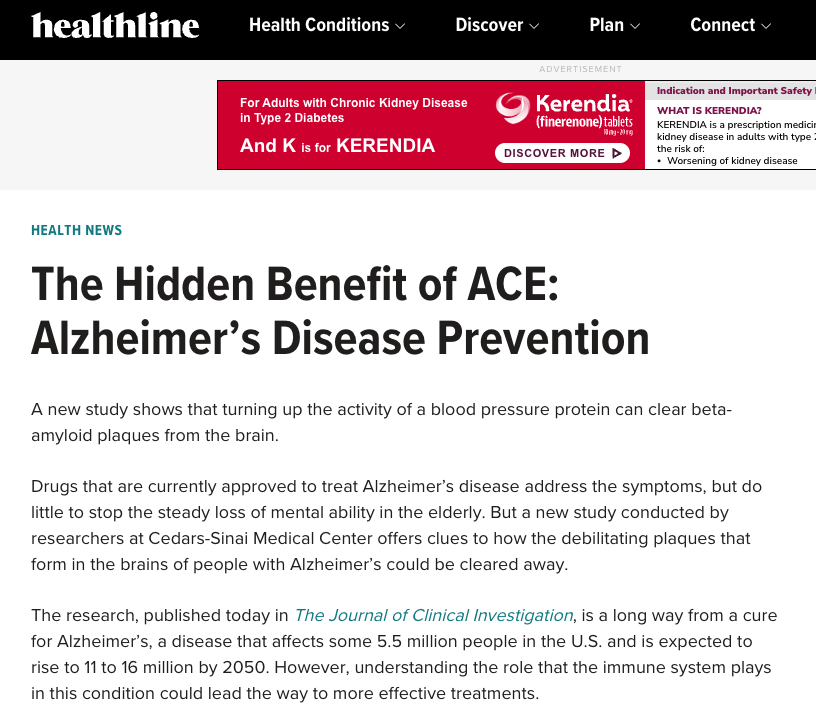
HEALTH NEWS The Hidden Benefit of ACE: Alzheimer’s Disease Prevention A new study shows that turning up the activity of a blood pressure protein can clear beta-amyloid plaques from the brain. Drugs that are currently approved to treat Alzheimer’s disease address the symptoms, but do little to stop the steady loss of mental ability in the elderly. But a new study conducted by researchers at Cedars-Sinai Medical Center offers clues to how the debilitating plaques that form in the brains of people with Alzheimer’s could be cleared away. The research, published today in The Journal of Clinical Investigation, is a long way from a cure for Alzheimer’s, a disease that affects some 5.5 million people in the U.S. and is expected to rise to 11 to 16 million by 2050. However, understanding the role that the immune system plays in this condition could lead the way to more effective treatments. Read More: A Brief History of Alzheimer’s Disease » Ramping Up ACE Protects the Brain Researchers focused on a naturally-occurring protein—angiotensin-converting enzyme, or ACE—that is found throughout the body. This enzyme is best known for its role in controlling blood pressure. Drugs called ACE inhibitors are used to treat high blood pressure by blocking the activity of the enzyme, leading to a widening of the blood vessels and a drop in blood pressure. But instead of lowering the effects of ACE, researchers ramped it up in specific cells in the immune systems of mice—including monocytes, macrophages, and microglia. Mice with the super-activated immune cells were then crossbred with mice that were genetically engineered to develop Alzheimer’s disease. Results showed that the offspring were protected from the effects of Alzheimer’s. In lab tests, their learning and memory skills were similar to those of normal mice. In addition, their brains showed a reduction in a protein—beta-amyloid—that has been associated with Alzheimer’s disease in humans. There was also a decrease in the number of brain plaques that occur when beta-amyloid proteins clump together. After initial tests, the researchers gave ACE inhibitors to the offspring mice. This reversed the brain benefits they experienced, implying that the enzyme was, in fact, responsible for protecting them from symptoms of Alzheimer’s. “We were absolutely astonished by the lack of Alzheimer’s-associated pathology in the crossed mice at the age of seven months and again at a 13-month follow-up,” said senior author Maya Koronyo-Hamaoui, an assistant professor of neurosurgery at Cedars-Sinai Medical Center, in a press release. “Even more importantly, this strategy resulted in a near-complete prevention of the cognitive decline in this mouse model of Alzheimer’s disease.” Learn More: What Causes Alzheimer’s Disease? » Enzyme Clears Away Brain Plaques Alzheimer’s is an age-related brain disorder that develops over a period of years. More than 90 percent of cases start after the age of 65, and symptoms include memory loss, confusion, and difficulty recognizing family and friends. Four drugs have been approved by the Food and Drug Administration (FDA) treat the symptoms of Alzheimer’s disease, but they don’t slow it’s progression, which eventually leads to a severe loss of mental function. Accumulation of beta-amyloid proteins in the brain—both in free form and as plaques—is associated with Alzheimer’s disease, although scientists still don’t know whether they directly cause the decline in mental ability. It is thought that the proteins may damage and destroy brain cells, as well as cause inflammation in the brain that further reduces mental function. Scientists also don’t know if the beta-amyloid proteins accumulate because the brain produces too much of them, or because the brain is unable to remove them quickly enough. By increasing the amount of ACE produced by immune cells that enter the brain, however, the researchers in this study were able to speed up the process by which beta-amyloid proteins are broken down and removed by the immune cells. Know the Signs and Symptoms of Alzheimer’s Disease » A Two-Pronged Approach To Prevention Because this research was done in mice, it will be a long time before it leads to practical treatments for Alzheimer’s disease in humans. In their paper, the researchers emphasize that, more importantly, their work proves that a two-prong approach to preventing damage done by beta-amyloid plaques in the brain can be successful. “While it is possible to envision a strategy for delivering ACE-overexpressing monocytes to patients,” the authors wrote, “perhaps the most informative finding of our studies is the effectiveness of combining an approach to enhance the immune response with that of delivering inflammatory cells to… destroy beta-amyloid.”
Spotlight on PLOS ONE’s Neuromapping and Therapeutics Collection
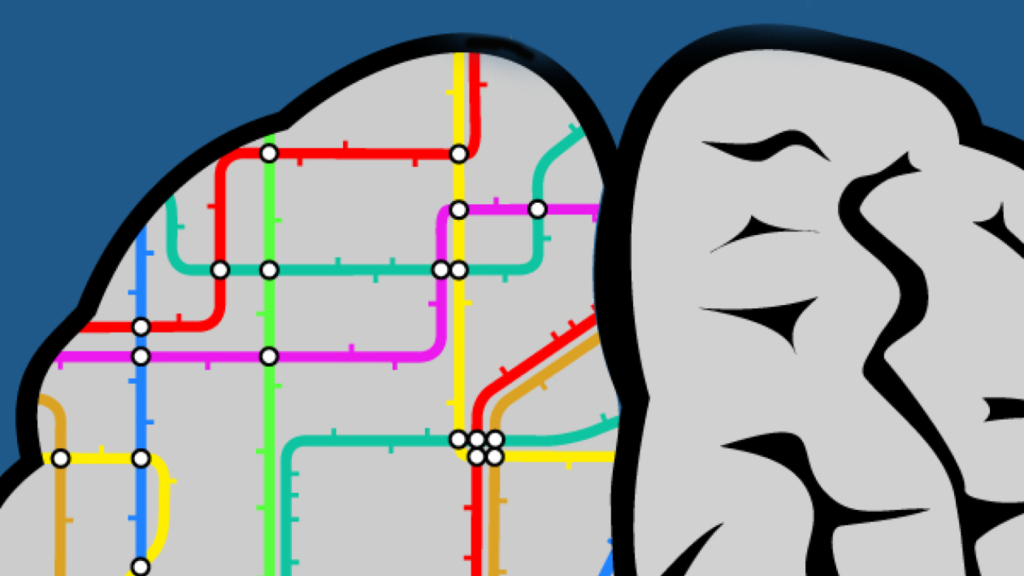
Launched in 2010, the Neuromapping and Therapeutics Collection is a unique collaboration between PLOS ONE and the Society for Brain Mapping and Therapeutics. The Neuromapping and Therapeutics Collection provides a forum for interdisciplinary research aimed at translation of knowledge across a number of fields such as neurosurgery, neurology, psychiatry, radiology, neuroscience, neuroengineering, and healthcare and policy issues that affect the treatment delivery and usage of related devices, drugs, and technologies. The Collection is open to submissions on these topics from any researcher—so far, 24 research papers have been published as part of this Collection. We spoke to Dr. Allyson Rosen, one of the members of the Society for Brain Mapping and Therapeutics who helps coordinate the Neuromapping and Therapeutics Collection, to discuss the latest news and research in this area, and the new submissions to the collection they’re hoping to see in the next few months: What’s exciting in Neuromapping and Therapeutics at the moment? It is exciting to see how creative scientists and clinicians are at solving important clinical problems by combining diverse techniques in innovative ways. We see our collection as a home for cross-disciplinary work that might not “fit” in traditional journals. For example, we have published MR methods to enable effective brain infusions and work that exploits computer-aided design for cranial reconstructions. There are invasive and non-invasive techniques for stimulating selective brain regions and creating focal lesions, such as transcranial magnetic stimulation, transcranial Doppler technology, and X-ray microplanar beam technology. There are also innovative analysis techniques that exploit powerful computational methods that were previously unavailable. What are the implications of President Obama’s commitment to Human Brain Mapping research? Given the high-profile nature of the Brain Mapping Initiative and the state of the US economy, we have advocated that there be some clinical implications to the announcement. We believe that this approach will ensure continued public support at a time of great need and uncertainty. Are there any specific research areas where you’d like to see more submissions to the Collection? We are proud of the work we’ve received and deeply impressed with the broad array of papers submitted so far. This is a testament to the creativity of our contributors, and we welcome their diversity. We particularly welcome work presented at the international meeting of the Society for Brain Mapping and Therapeutics that occurs in the spring of each year. Why do you think it’s important to publish this kind of research in an open access journal such as PLOS ONE? Our society is committed to being inclusive and welcoming any profession that seeks to improve the health and wellbeing of patients with brain disorders. An open access journal enables easier promotion of work we feel is important and encourages sharing among diverse disciplines. Often, truly cutting-edge work is so far ahead of its time that there is not yet an appreciation for its importance. Often, clinical problems are seen as practical but not necessarily novel. We appreciate the mission of PLOS ONE as upholding strong scientific integrity and not as triaging work based on arbitrary decisions regarding importance. To read more about this Collection, including new research papers like, “Verifying three-dimensional skull model reconstruction using cranial index of symmetry” and “Unique anti-glioblastoma activities of Hypericin are at the crossroad of biochemical and epigenetic events and culminate in Tumor Cell Differentiation,” click here. Come visit us at SFN 2013. Both the Society for Brain Mapping and Therapeutics and PLOS ONE will be attending SFN 2013 – please drop by booth #136 to say hello and learn more about the Collection. For instructions on how to submit to the Collection, please visit the Collection page and download the submission document. If you have any questions about this Collection, or any other PLOS Collections, please email collections@plos.org Image credit for Collection cover: Alka Joshi Image Credit: Society for Brain Mapping & Therapeutics
Dr. Ramin Rak Elected To Board Of Directors Of The Society For Brain Mapping And Therapeutics

Leading Neurosurgeon to Represent NY Area on the Board of Prominent International Scientific Group Aimed at Introducing Game-Changing Diagnostics, Treatments for Neurological Disorders; Will Chair 2018 World Congress for Brain Mapping in NY ROCKVILLE CENTRE, NY – Leading neurosurgeon Ramin Rak, M.D., F.A.AN.S., F.A.C.S., Co-Surgical Director of the Long Island Brain Tumor Center at NSPC Brain & Spine Surgery (NSPC) (NSPC) and Director of the Brain Tumor Program at NS-LIJ Huntington Hospital, has been elected to the Board of Directors of the Society for Brain Mapping and Therapeutics (SBMT). SBMT is one of the world’s leading multidisciplinary and translational neuroscience medical associations with a network of nearly 200,000 scientists, engineers, physicians and surgeons worldwide. Dr. Rak will represent the New York area on the board of this prestigious international organization. He was also appointed to chair the Science Committee for the 15th annual World Brain Mapping and Therapeutics Congress, which will take place in New York in 2018. Dr. Rak is a resident of Woodbury, NY. The SBMT board consists of the world’s leading neuroscientists, engineers, radiologists, neurologists and neurosurgeons involved in researching and applying paradigm-shifting technologies in the area of brain mapping and therapeutics in order to better prevent, diagnose and treat serious neurological disorders. SBMT is the leading global advocate for the brain mapping field and a strong supporter of President Obama’s new “BRAIN” brain mapping initiative. The Society also led formation of the Nano-Bio-Electronic Consortium of leading international scientists, with the purpose of integrating nanotechnology, devices, imaging, pharmaceuticals and cellular/stem cell therapeutics. “This is a new era in neurosurgery and neuroscience, and the Society for Brain Mapping and Therapeutics is at the forefront of these advances,” says Dr. Rak. “A clear example of their forward-looking approach is their recent pioneering publication, The Textbook of Nanoneuroscience and Nanoneurosurgery. It is a thrill to be part of this effort and an honor to join so many of the world’s leaders in brain mapping on the SBMT Board of Directors.” The Society for Brain Mapping and Therapeutics is a non-profit scientific society organized for the purpose of encouraging basic and clinical scientists who are interested in the areas of brain mapping, engineering, stem cells, nanotechnology, imaging and medical devices to improve the diagnosis, treatment and rehabilitation of patients afflicted with neurological disorders. The Society achieves its mission through multi-disciplinary collaborations with government agencies, patient advocacy groups, educational institutes and industry as well as philanthropic organizations. “Nomination to the SBMT Board of Directors is based on criteria that include stellar academic accomplishments, exemplary and visionary leadership skills, unique personal characteristics and attributes, and the ability to work closely with a diverse group of scientists in order to achieve the Society’s mission,” says Dr. Babak Kateb, Founding Chairman of the Board and Scientific Director of SBMT; President of the Brain Mapping Foundation; Director of the National Center for NanoBioElectronics; Visiting Scientist at NASA/JPL; Senior Editor of PLoSOne-NeuroMapping and Therapeutics Journal; Editor of The Textbook of NanoNeuroscience and NanoNeurosurgery; and Researcher, Maxine Dunitz Neurosurgical Institute of the Department of Neurosurgery, Cedars-Sinai Medical Center (Los Angeles). “Unlike other boards, the SBMT board is an eclectic selection of pioneers in the field and individuals with a unique vision for the future of the field of neuroscience and biomedical sciences in general. I am confident that Dr. Rak’s visionary leadership and abilities will help us introduce new diagnostics and treatments by bringing scientists across disciplines together in our world congress in New York. ” Dr. Rak is one of the New York region’s leading experts in intraoperative brain mapping in brain tumor surgeries – the use of sophisticated imaging technologies to plan and guide surgery, in order to get the best understanding of each patient’s brain structure and function. He uses brain mapping to guide awake craniotomies – operations in which the patient is awakened during surgery and asked to perform certain tasks in order to avoid touching brain areas that control critical functions (eloquent areas of the brain). In these procedures, Dr. Rak maps the patient’s brain using functional MRI (fMRI) scans before the surgery to begin identifying functional areas that are affected by the tumor. fMRI scans are done at the same time as neuropsychological tests to see how and where the patient’s brain reacts when the patient completes certain tasks. The fMRI scans are combined with standard MRI and other medical images and programmed into a sophisticated computerized neuronavigation system. This creates a complete picture of brain anatomy and function, and their relationship to tumor structure. These images are used to help guide the surgery. “The more we do these surgeries, the more we find out that every person’s brain is wired differently and our ability to treat many of these diseases is hindered by a lack of viable technologies and treatments. This is why we need to think outside of the box, so that we can introduce new diagnostics and treatments for our patients, and this is why SBMT’s mission is so critical for our field and our patients,” says Dr. Rak, who recently returned from an advanced educational trip to France, where he worked closely for a week with Dr. Hugues Duffau. Dr. Duffau is considered one of the pioneers of brain mapping. Dr. Rak is already in the process of setting up a series of meetings between SBMT leadership and leaders of the New York health care and scientific communities in order to jumpstart building of the NanoBioElectronic Consortium in the New York area. Dr. Rak expects to be involved in a number of research projects through his SBMT board membership. He has scheduled a visit to California, where he will learn more about an advanced ultraviolet camera developed by NASA’s Jet Propulsion Laboratory and tested by Cedars-Sinai Medical Center scientists Drs. Keith L. Black, Babak Kateb, Shouleh Nikzad (NASA/JPL) and other colleagues at Cedars-Sinai Medical Center, Maxine Dunitz Neurosurgical Institute and NASA/JPL. The current pilot study seeks to determine if the camera can provide visual detail that will help surgeons distinguish areas of healthy brain from deadly tumors called gliomas, which have irregular borders
Can we predict Alzheimer’s a decade before symptoms?

One day when she was 76 years old, Rosa Rodrigo took a wrong turn out of a shopping center parking lot and found she had no idea where to turn next. “It was a little scary because I didn’t remember where I came from, or where I was going,” she recalls. While Rodrigo and her family were alarmed, it was only after several more years of fading memory and worsening mental condition that Rodrigo was diagnosed with Alzheimer’s disease. Almost since the disease was identified back in 1906 by Dr. Alois Alzheimer, scientists have been looking for ways to identify it earlier. We do know the disease process begins in the brain 10 to 15 years before a patient’s symptoms start. And, by the time memory problems develop, 40% to 50% of a patient’s brain cells have already been affected or destroyed. There are certain hallmarks of Alzheimer’s, including the accumulation of sticky plaques in the brain, made up of proteins called beta amyloid. The problem is that current technology cannot conclusively confirm the presence of the plaques. Last year, the Food and Drug Administration approved a brain imaging test – a type of PET scan – to detect the presence of amyloid proteins in the brain. The FDA made clear, however, that the scan alone is not enough to diagnose Alzheimer’s. And, while examination of the spinal fluid or even a brain biopsy may offer a more definitive glimpse of what is happening in the brain, they require invasive procedures and it is not even clear who would be a candidate. In most instances, the best we have now is a clinical neurological exam after the patient has already suffered memory loss. That is why recent research caught my attention. Studying cadavers, researchers at Cedars-Sinai Medical Center in Los Angeles made an interesting observation: The amount of beta amyloid protein in the brain corresponded closely to the amount of that same protein in the retina, in the very back of the eye. It makes sense because, as our bodies develop from embryos, the retina is ultimately formed from the same tissue that makes up the brain. Based on that finding, the research team developed a noninvasive test to check the retina for the telltale beta amyloid plaques. They’re now conducting a clinical trial to see if the test can identify patients who are starting to develop Alzheimer’s but don’t show symptoms yet. Rosa Rodrigo knows that in a very real sense, her disease was caught too late. Most days, she copes with grace. “I don’t even worry about it. If I remember [something], fine. If I don’t, que sera, sera. What will be, will be,” she said. But even though she knows she won’t reap direct benefits, she signed up for the Cedars-Sinai trial. “I’m very happy I can help somebody.” We don’t know yet if the test will provide to be a good predictor of Alzheimer’s, but officials at the Chicago-based Alzheimer’s Association say the work is promising. This image from NeuroVision Imaging shows beta-amyloid plaques, highlighted in red, inside the retina.Neurovision Imaging A reliable eye test “would be a very important contribution,” says Maria Carrillo, the Vice-President of Medical and Scientific Relations at the Alzheimer’s Association. “People tend to go to the opthamologist more frequently as we age. If you could add a quick test to see if neurogenic pathology is going on the brain, it would be really helpful.” This research is important, because 1 in 8 people who are 65 and older have Alzheimer’s disease, and the incidence of the disease is expected to nearly triple by 2050 as the number of older Americans grows. The expected cost of care at that time is expected to be more than $1 trillion a year. The 10 warning signs of Alzheimer’s The trial at Cedars-Sinai is not the only one to focus on the eyes, Carrillo says. Another company, Cognoptix, has a test that looks for amyloid proteins in the lens of the eye. “We think it will provide greater sensitivity and specificity than looking in the retina,” says Paul Hartung, the company’s president and CEO. Cognoptix presented early data at the June meeting of the Alzheimer’s Association, and is currently in the midst of a clinical trial with 40 patients. If it proves effective, says Hartung, the test would run approximately one-tenth the cost of the PET scan procedure. VIDEO World’s Untold Stories: Dementia Village Another test being developed tracks subtle eye flickers known as saccadic movements, says Carrillo. “When people start to have cognitive changes, these movements become more erratic, and slower,” she explains. Yet another approach looks for changes in blood vessel infrastructure. “It may not be specific to Alzheimer’s,” Carrillo notes, “but a big part of this research initiative is trying to find what is different between this and other neurological disorders.” ‘Dementia village’ inspires new way to care Dr. Keith Black, a neurosurgeon who is leading the Cedars-Sinai trial and who helped found a company to develop the retinal imaging test, says the problem with treatments being tested currently is that they’re being given to patients at the end stage of the disease. “If we can identify patients at 50 who are accumulating these plaques, and stop these plaques from accumulating, we have a much better chance of having an effective treatment,” Black said. I want to be careful to not overstate the significance of early detection, however. While we doctors always love to catch things early, it is with the hope that it leads to earlier treatment. Unfortunately, with Alzheimer’s, there isn’t yet a treatment proven to cure or even slow down the disease. While it is certainly possible that a technology like this could present an opportunity to intervene earlier and to create strategies to measure the effectiveness of those interventions, the ultimate advice to patients may sound very familiar: Eat right and get plenty of physical exercise, which is something we should all be doing anyway. I do
Breakthrough Device To Treat Neurological Disorders
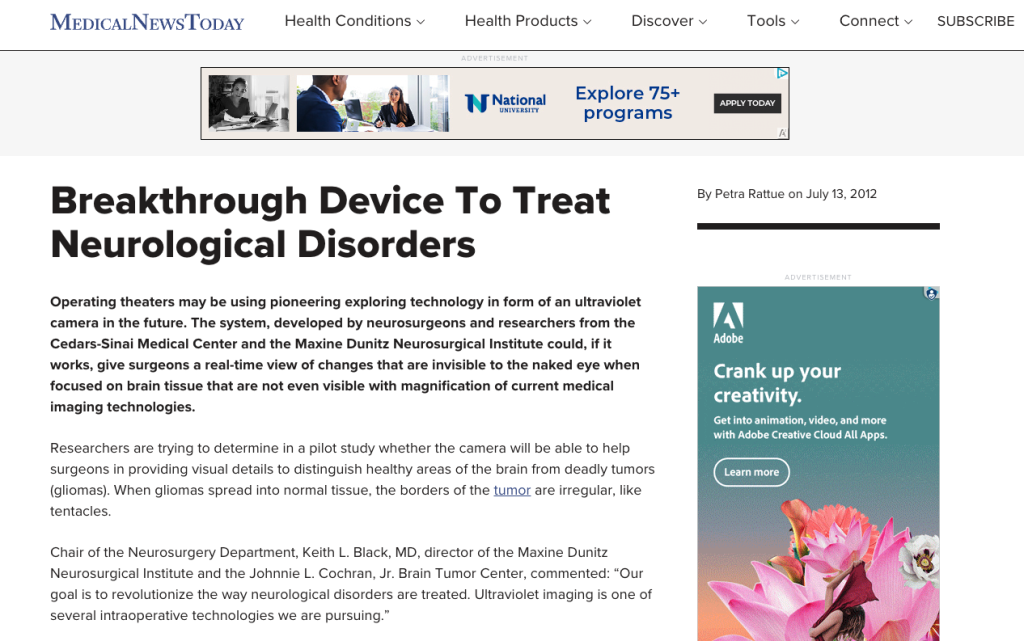
Operating theaters may be using pioneering exploring technology in form of an ultraviolet camera in the future. The system, developed by neurosurgeons and researchers from the Cedars-Sinai Medical Center and the Maxine Dunitz Neurosurgical Institute could, if it works, give surgeons a real-time view of changes that are invisible to the naked eye when focused on brain tissue that are not even visible with magnification of current medical imaging technologies. Researchers are trying to determine in a pilot study whether the camera will be able to help surgeons in providing visual details to distinguish healthy areas of the brain from deadly tumors (gliomas). When gliomas spread into normal tissue, the borders of the tumor are irregular, like tentacles. Chair of the Neurosurgery Department, Keith L. Black, MD, director of the Maxine Dunitz Neurosurgical Institute and the Johnnie L. Cochran, Jr. Brain Tumor Center, commented: “Our goal is to revolutionize the way neurological disorders are treated. Ultraviolet imaging is one of several intraoperative technologies we are pursuing.” The long tentacles of the glioma present neurosurgeons with difficult challenges; if they surgically remove too much normal brain tissue the consequences could be catastrophic, yet not removing enough means that the cancer cells grow back quickly. According to Black, determining the precise line where tumor cells end and healthy cells start is always difficult, even with recent advances in medical imaging systems. He continued saying that it may be possible that an ultraviolet camera could see below the surface, because tumor cells are more active and need more energy than normal cells, the tumor cells accumulate a NADH, a specific chemical (nicotinamide adenine dinucleotide hydrogenase) that is not visible in healthy cells. The camera, which is on loan from NASA’s Jet Propulsion Laboratory, may capture the ultraviolet light, which is emitted by the NADH and display the area in a high-resolution image. Leading researcher Ray Chu, MD, a neurosurgeon and his co-principal investigator Babak Kateb, MD, a research scientist at Cedars-Sinai’s Maxine Dunitz Neurosurgical Institute and chairman of the board of the Society for Brain Mapping and Therapeutics, declared: “The ultraviolet imaging technique may provide a ‘metabolic map’ of tumors that could help us differentiate them from normal surrounding brain tissue, providing useful, real-time, intraoperative information.” Kateb commented: “This study and equipment-sharing arrangement represents the leading edge of an effort by Cedars-Sinai to develop the next generation of solutions for brain tumors, injuries and other neurological disorders right here at Cedars-Sinai’s Maxine Dunitz Neurosurgical Institute by introducing paradigm-shifting technologies into the field.” During the clinical trial, the researchers place the highly sensitive camera near the surgical field to record images as the neurosurgeon exposes and removes the tumor. The images will not be used in decision-making or surgical technique. To assess the ultraviolet technology’s efficacy during surgery, the images will be correlated with the appearance of the tumor, laboratory findings, and MRI and CT scans at a later stage. Written by Petra Rattue
AusBiotech secures Australian first with world brain mapping congress
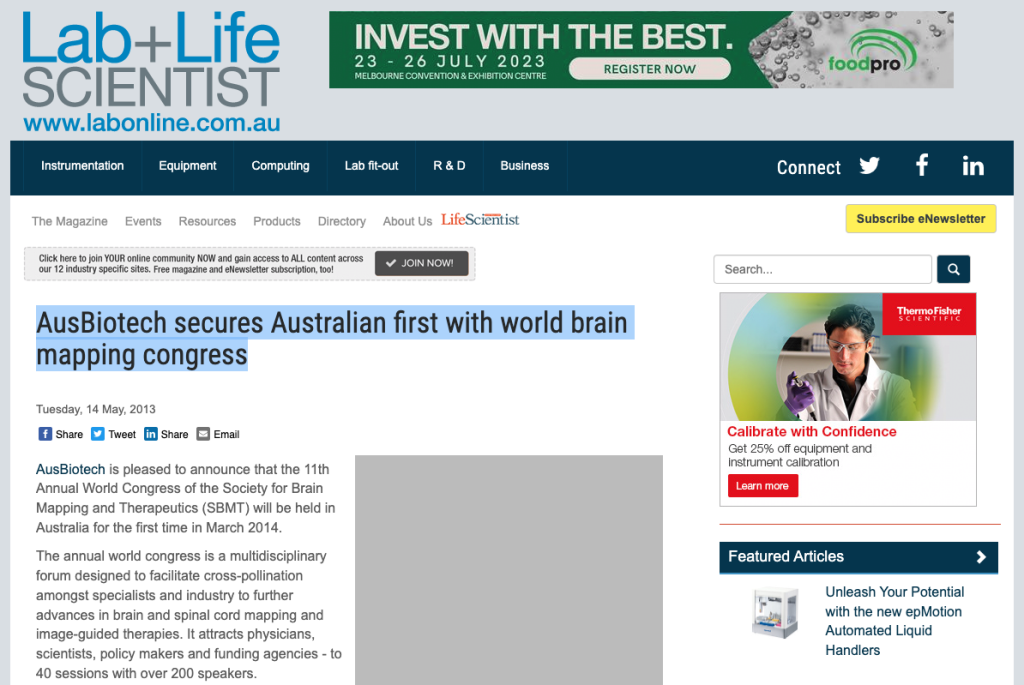
AusBiotech is pleased to announce that the 11th Annual World Congress of the Society for Brain Mapping and Therapeutics (SBMT) will be held in Australia for the first time in March 2014. The annual world congress is a multidisciplinary forum designed to facilitate cross-pollination amongst specialists and industry to further advances in brain and spinal cord mapping and image-guided therapies. It attracts physicians, scientists, policy makers and funding agencies – to 40 sessions with over 200 speakers. Acting Chief Executive Officer of AusBiotech Glenn Cross made the announcement while attending the 10th SBMT Congress in Baltimore, Maryland, USA. “This is a big win for Australia and AusBiotech is honoured to be asked to organise this important international event,” he said. “It will provide an opportunity for Australian life sciences experts to showcase their work and advancements on the world stage.” AusBiotech has a long history of producing successful science and technology events, such as the AusBiotech annual conference. Through its AusEvents division (life sciences and technology events), the SBMT will be organised by an experienced and well-connected team. The theme for the 2014 Congress will be ‘Brain Therapeutics – bringing together engineering, science and medicine’. The program will highlight state-of-the-art science and technology in the field of neuroscience, engineering, neurosurgery, psychiatry, psychology, molecular biology, neurology, radiology and oncology, and will also feature emerging areas such as nanobiotechnology, stem cell and regenerative medicine, molecular psychiatry and microsurgery. The Congress committee is being co-convened by internationally acclaimed brain surgeon Dr Charlie Teo, Director of the Centre for Minimally Invasive Neurosurgery and Chairman of Neurosurgery at the Prince of Wales Private Hospital in Sydney, and stem cell specialist Associate Professor Kuldip Sidhu, Faculty of Medicine at the University of New South Wales. Dr Babak Kateb from the Maxine Dunitz Neurosurgical Institute in California will chair the organising committee. The 11th Annual World Congress for SBMT will be held from 17-19 March 2014 at the Four Seasons Hotel in Sydney. For information on congress bookings, abstract submissions or exhibition and partnership opportunities, contact Events Manager Kirsty Grimwade at kgrimwade@ausbiotech.org.
Aus to host first world brain mapping congress

Singapore: AusBiotech is holding 11th Annual World Congress of the Society for Brain Mapping and Therapeutics (SBMT) in Sydney, Australia, for the first time ever. The theme for the 2014 congress will be ‘Brain Therapeutics-bringing together engineering, science and medicine’. The program will highlight state-of-the-art science and technology in the field of neuroscience, engineering, neurosurgery, psychiatry, psychology, molecular biology, neurology, radiology and oncology, and will also feature emerging areas such as nano-biotechnology, stem cell and regenerative medicine, molecular psychiatry and micro-surgery. The annual world congress, which will be held during March 2014 and feature 40 sessions and over 200 speakers, will be a multidisciplinary forum designed to facilitate cross-pollination amongst specialists and the industry to further advances in brain and spinal cord mapping and image-guided therapies. It will attract physicians, scientists, policy makers and funding agencies. Dr Glenn Cross, CEO, AusBiotech, said that, “This is a big win for Australia and AusBiotech is honoured to be asked to organise this important international event. It will provide an opportunity for Australian life sciences experts to showcase their work and advancements on the world-stage.”
Neurosurgery Chair Invited to Speak to Congressional Neuroscience Caucus May 10

Keith L. Black, MD, will describe an experimental, noninvasive method to diagnose Alzheimer’s disease before cognitive symptoms begin Los Angeles – May 8, 2013 – Keith L. Black, MD, chair of the Department of Neurosurgery at Cedars-Sinai Medical Center, will present information to the Congressional Neuroscience Caucus on a new, experimental method to provide early detection of Alzheimer’s disease. The noninvasive diagnostic procedure — which is in clinical trials — looks at the retina of the eye for early changes signaling the onset of Alzheimer’s. Black, director of the Maxine Dunitz Neurosurgical Institute, director of the Johnnie L. Cochran, Jr. Brain Tumor Center and the Ruth and Lawrence Harvey Chair in Neuroscience at Cedars-Sinai, is one of 10 speakers invited to participate at the panel’s second annual session on brain mapping, which will be from 10 a.m. to noon EST May 10 in the Gold Room of the Rayburn House Office Building, 45 Independence Ave. SW, Washington, D.C. The Congressional Neuroscience Caucus, co-chaired by Reps. Earl Blumenauer and Cathy McMorris Rodgers, aims “to build awareness of the intrinsic role brain research plays in understanding ourselves and our society, to help communicate the progress and the benefits of this research, and to help inform federal policy,” according to Blumenauer’s website. Members embrace “policies that encourage support for funding of quality neuroscience research (and) that enhance translation and dissemination of discoveries to maximize the medical and societal benefits of research.” Cedars-Sinai researchers showed that beta-amyloid protein plaques associated with Alzheimer’s disease occur not only in the brain but also in the retina in the back of the eye; the deposits can be seen in the retina even before they begin to accumulate in the brain. With these advances, the researchers developed a device that enables doctors to look through the eye — just as an ophthalmologist diagnoses retinal disease — to visualize amyloid plaques in the retina. Results of preclinical studies were encouraging, and the researchers now are working with major pharmaceutical companies to evaluate the technology in patient trials. The objective is to provide a quick, inexpensive, noninvasive way to screen patients for Alzheimer’s in its first stages so emerging treatments may be started early to slow or stop the progression of the disease. The Congressional Neuroscience Caucus’s annual brain mapping program is presented with the support of the Brain Mapping Foundation.
